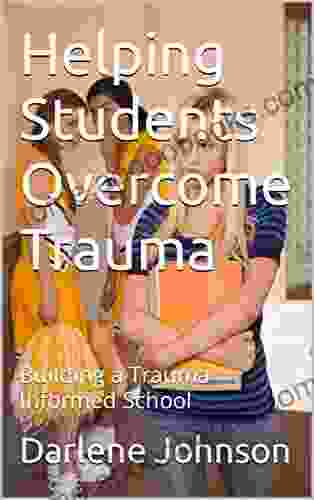Rebuilding Trauma Informed School: Creating a Safe and Supportive Learning Environment

5 out of 5
| Language | : | English |
| File size | : | 22563 KB |
| Print length | : | 164 pages |
Trauma is a serious and widespread issue that can have a devastating impact on children and their education. Trauma can come from a variety of sources, such as abuse, neglect, violence, or natural disasters. When children experience trauma, they may have difficulty concentrating, learning, and behaving. They may also be more likely to develop mental health problems, such as anxiety, depression, and post-traumatic stress disFree Download (PTSD).
Schools play a vital role in providing support for children who have experienced trauma. By creating trauma-informed schools, educators can help students to feel safe, supported, and connected to their learning. Trauma-informed schools are schools that understand the impact of trauma on children and that have policies and procedures in place to support students who have experienced trauma.
This book provides a comprehensive guide to building trauma-informed schools. It covers a wide range of topics, including:
- The impact of trauma on children
- The principles of trauma-informed education
- How to create a trauma-informed school environment
- How to support students who have experienced trauma
- How to create partnerships with families and community organizations
This book is an essential resource for educators who want to create safe and supportive learning environments for all students. It is also a valuable resource for parents and community members who want to learn more about trauma and its impact on children.
Chapter 1: The Impact of Trauma on Children
Trauma is a serious issue that can have a devastating impact on children. Trauma can come from a variety of sources, such as abuse, neglect, violence, or natural disasters. When children experience trauma, they may have difficulty concentrating, learning, and behaving. They may also be more likely to develop mental health problems, such as anxiety, depression, and post-traumatic stress disFree Download (PTSD).
The impact of trauma on children can be profound. Trauma can affect a child's physical, emotional, social, and cognitive development. Children who have experienced trauma may have difficulty:
- Concentrating and learning
- Behaving appropriately
- Building relationships
- Regulating their emotions
- Developing a sense of self
Trauma can also have a lasting impact on a child's physical health. Children who have experienced trauma are more likely to develop chronic health conditions, such as heart disease, diabetes, and obesity. They are also more likely to engage in risky behaviors, such as smoking, drinking, and drug use.
It is important to remember that not all children who experience trauma will develop serious problems. Many children are resilient and will be able to recover from trauma with the help of supportive adults. However, it is important to be aware of the potential impact of trauma on children so that you can provide them with the support they need.
Chapter 2: The Principles of Trauma-Informed Education
Trauma-informed education is an approach to education that is based on the understanding that trauma is a serious issue that can have a devastating impact on children. Trauma-informed schools are schools that understand the impact of trauma on children and that have policies and procedures in place to support students who have experienced trauma.
The principles of trauma-informed education include:
- Safety: Students need to feel safe in Free Download to learn. This means creating a physically and emotionally safe environment where students feel respected and supported.
- Trustworthiness and Transparency: Students need to be able to trust the adults in their school. This means being honest with students, keeping them informed, and following through on promises.
- Choice: Students need to have a sense of control over their lives. This means giving students choices whenever possible, such as choosing where to sit in the classroom or what activities to participate in.
- Collaboration: Students need to feel like they are part of a community. This means involving students in decision-making and creating opportunities for them to connect with each other and with adults.
- Empowerment: Students need to feel like they have the power to make a difference in their own lives. This means giving students opportunities to take on leadership roles and to make decisions about their own education.
These principles are essential for creating a trauma-informed school environment. By implementing these principles, schools can help students to feel safe, supported, and connected to their learning.
Chapter 3: How to Create a Trauma-Informed School Environment
Creating a trauma-informed school environment is a complex and multifaceted process. However, there are a number of things that schools can do to create a more supportive and welcoming environment for students who have experienced trauma.
Some of the key steps to creating a trauma-informed school environment include:
- Establish a school-wide commitment to trauma-informed education. This means getting buy-in from all stakeholders, including administrators, teachers, staff, parents, and students.
- Train staff on trauma-informed principles and practices. This includes training on the impact of trauma on
5 out of 5
| Language | : | English |
| File size | : | 22563 KB |
| Print length | : | 164 pages |
Do you want to contribute by writing guest posts on this blog?
Please contact us and send us a resume of previous articles that you have written.
 Book
Book Novel
Novel Page
Page Chapter
Chapter Text
Text Story
Story Genre
Genre Reader
Reader Library
Library Paperback
Paperback E-book
E-book Magazine
Magazine Newspaper
Newspaper Paragraph
Paragraph Sentence
Sentence Bookmark
Bookmark Shelf
Shelf Glossary
Glossary Bibliography
Bibliography Foreword
Foreword Preface
Preface Synopsis
Synopsis Annotation
Annotation Footnote
Footnote Manuscript
Manuscript Scroll
Scroll Codex
Codex Tome
Tome Bestseller
Bestseller Classics
Classics Library card
Library card Narrative
Narrative Biography
Biography Autobiography
Autobiography Memoir
Memoir Reference
Reference Encyclopedia
Encyclopedia Anthea Cohen
Anthea Cohen Avid Reader
Avid Reader Jenna Arnold
Jenna Arnold Atrey Tejas Rayaprolu
Atrey Tejas Rayaprolu Annika Sharma
Annika Sharma Ben Epstein
Ben Epstein Holly J Martin
Holly J Martin Daniel Borzutzky
Daniel Borzutzky Anouar Boukhars
Anouar Boukhars Gary Johnson
Gary Johnson Anthony Wood
Anthony Wood Diana L Howles
Diana L Howles Lawrence F Katz
Lawrence F Katz Lynne A Weikart
Lynne A Weikart Ava Mcarthur
Ava Mcarthur Richard Moran
Richard Moran J N Welch
J N Welch Avijit Mathur
Avijit Mathur Arthur Cravan
Arthur Cravan Tina Blythe
Tina Blythe
Light bulbAdvertise smarter! Our strategic ad space ensures maximum exposure. Reserve your spot today!

 George MartinEmbark on a Journey Through the Intersecting Histories of Black and Native...
George MartinEmbark on a Journey Through the Intersecting Histories of Black and Native...
 Hamilton BellCapture the Moment: Immerse Yourself in the Thrilling World of "Who Watchin...
Hamilton BellCapture the Moment: Immerse Yourself in the Thrilling World of "Who Watchin... Dwight BellFollow ·12k
Dwight BellFollow ·12k Alfred RossFollow ·7.8k
Alfred RossFollow ·7.8k Enrique BlairFollow ·6.3k
Enrique BlairFollow ·6.3k Lucas ReedFollow ·2.5k
Lucas ReedFollow ·2.5k Thomas HardyFollow ·19k
Thomas HardyFollow ·19k Troy SimmonsFollow ·17.3k
Troy SimmonsFollow ·17.3k Jean BlairFollow ·9.1k
Jean BlairFollow ·9.1k Leon FosterFollow ·18.5k
Leon FosterFollow ·18.5k

 Gabriel Garcia Marquez
Gabriel Garcia MarquezLad Dog Baby Professor: The Perfect Book for Your Child
Lad Dog Baby...

 Fredrick Cox
Fredrick CoxAn Excerpt With Fifty Ways To Help Animals Promo Books:...
: Embracing Animal...

 Kelly Blair
Kelly Blair5th Grade US History: Famous US Authors: Fifth Grade...
Step into a captivating world of historical...

 Natsume Sōseki
Natsume SōsekiKull the Destroyer: A Timeless Tale of Sword and Sorcery
The Creation of a...

 Jim Cox
Jim CoxDas Ist Supertoll: Unlocking the Magic of German for Kids
Immersive Learning with...

 Bruce Snyder
Bruce SnyderUnlock the World of Quilting for Kids: Discover "Quick...
Are you ready to embark on a delightful...
5 out of 5
| Language | : | English |
| File size | : | 22563 KB |
| Print length | : | 164 pages |








